Car starter. We select a device for starting the engine with a dead battery. What to look out for
With the onset of winter cold, many car owners face a problem: how to start?. Probably, there is not a single driver who would not ask for a "light" when No one is insured against a sudden stop of the battery. There are many reasons for discharging and breaking batteries. Before deciding on specific actions, it is necessary to familiarize yourself with all of them in more detail.
Reasons for a dead battery
There may be several of them:
- Expiration of battery life;
- Battery failure;
- Untimely recharging of the battery;
- Improper operation, frequent recharging.
How to start it? What to do if the car battery runs down in the middle of the road? These questions concern many. Most batteries lose their charge in cold weather. This is facilitated by a sharp change in temperature conditions. The cold time does not benefit the device. This is especially true for machines that long time are on the street. Also of no small importance for operation in the cold season is the load. If the load is excessive, it is natural that the device will be discharged faster, and this will lead to a decrease in its shelf life. You can get out of this situation.
Extending battery life
Ways to minimize battery failure:
- proper operation of the vehicle, which provides for proper care of it at sub-zero temperatures. In other words, the car low temperatures can be left in the cold only if the battery is removed from it;
- do not leave the vehicle unattended for a long time;
- if it is necessary to provide an emergency method of charging or have a spare one;
- you can try to “light up” the engine or ask other motorists to do it;
- use special Charger for fast
There are cases when it is impossible to count on someone's help and only a special device can help. Therefore, the best way out of this situation is considered to be a one-time cost of funds for the purchase of charging equipment.
Devices for starting the engine with a dead battery can be varied:
- Asian origin;
- European;
- CIS countries.
Sometimes a starting device for a car is called a booster. Unknowing people consider this device to be auxiliary. 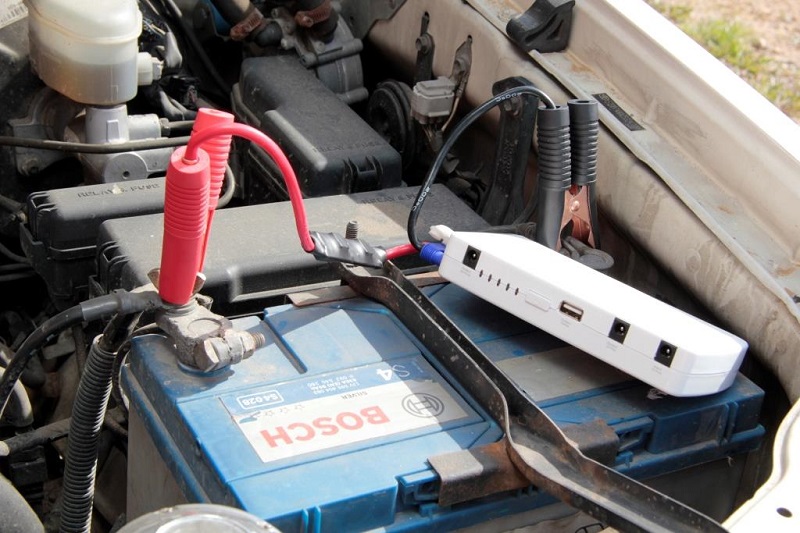 But they are deeply mistaken. This is a completely separate equipment with certain quality characteristics:
But they are deeply mistaken. This is a completely separate equipment with certain quality characteristics:
- its capacity is much less than a conventional battery;
- the internal "stuffing" is also different;
- produces a different voltage.
Connecting a device to start the engine with a dead battery provides for its connection to power unit vehicle. This booster is only suitable for cars, since the power for its use must be about 12 V.
How to use the device?
Tricks to use:
- The process of operating a device for starting an engine with a dead battery involves throwing "crocodiles" on a dead battery, as a result of which an electric current will appear. The rules for using devices are different for each manufacturer. Therefore, before using it, you must carefully read the instructions, and only then take action.
- Starting the engine with a starting device should not harm the battery. A single exposure to the battery should not exceed ten seconds.
- Charging works only from the mains. Therefore, if trouble happens on the road, only a cigarette lighter can help.
- When operating the booster, it is contraindicated to leave the device in the cold for a long time.
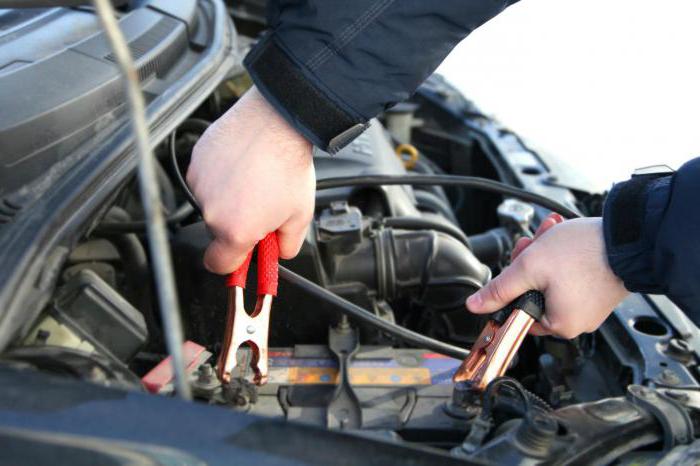 Exceptions are professional and semi-professional devices used by car service specialists.
Exceptions are professional and semi-professional devices used by car service specialists.
Functional features of the device
If you decide to purchase a charger, the best option would be a device that contains a battery indicator indicator. 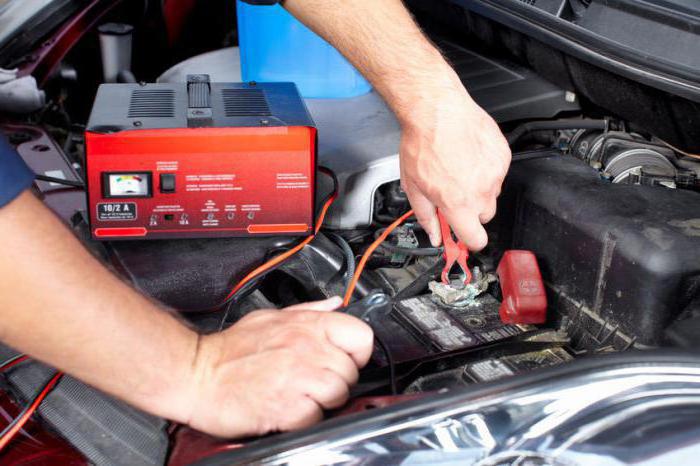 In the absence of this functionality, it will be difficult to use the starting device for the car. How to choose it correctly? When buying a device to start the engine with a dead battery, you need to pay attention to the following indicators:
In the absence of this functionality, it will be difficult to use the starting device for the car. How to choose it correctly? When buying a device to start the engine with a dead battery, you need to pay attention to the following indicators:
- the device must have built-in zero discharge protection, since such a device will last much longer;
- the possibility of further charging;
- the power of the purchased device must be appropriate.
To avoid trouble, purchase equipment in specialized stores that can provide relevant documentation on the quality and safety of the product. Only in this way you can protect yourself and your transport.
How is the process carried out using a quick start engine?
First you need to know that when connecting, you must observe the correct polarity. 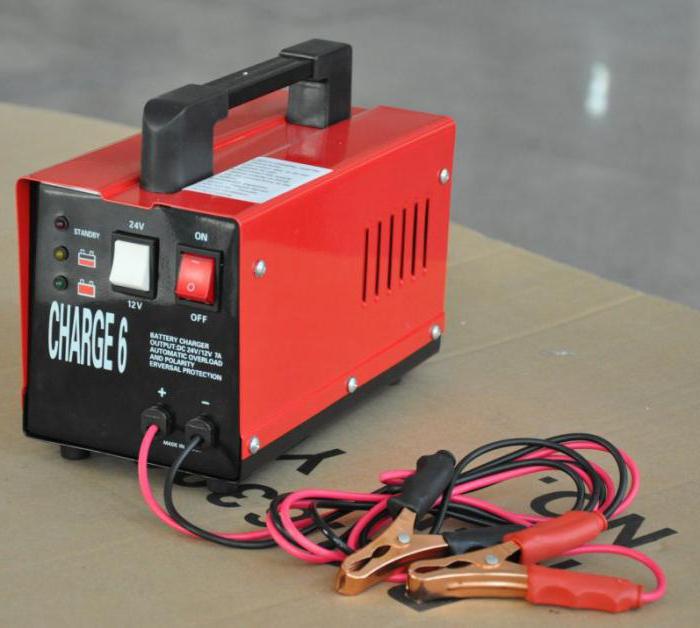 The next step should be to control a certain voltage flow, which should be 20 A. Depending on the battery, certain errors can be observed, but they should be minimal.
The next step should be to control a certain voltage flow, which should be 20 A. Depending on the battery, certain errors can be observed, but they should be minimal.
As the battery charges, the following conditions may occur:
- electrolyte viscosity decrease;
- drop in internal resistance;
- an increase in the starter capacity of the battery.
If you turned on the battery starter, the battery was fully charged, then the voltage at its terminals should quickly reach the required values and it is not recommended to recharge it. In this case, you should pay attention to turning on the starter of the charger-starter. If, after the measures taken, your vehicle still does not start, turn off the ignition and give it the opportunity to rest a bit. 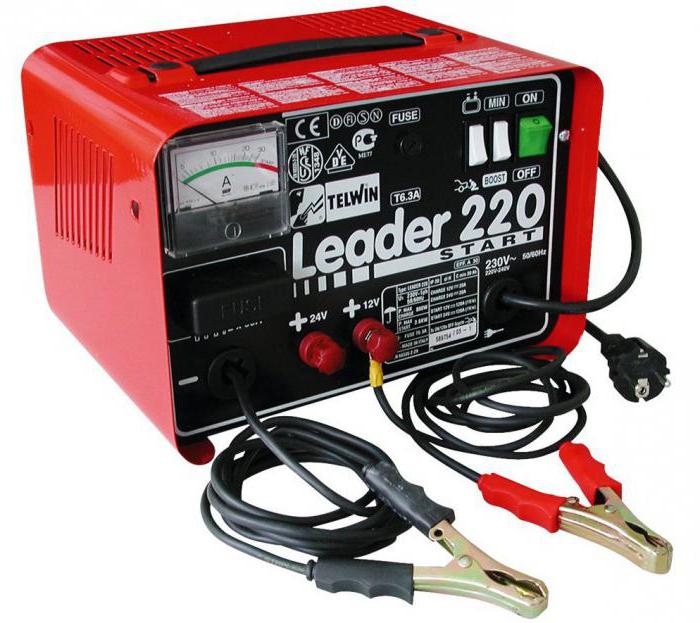 Practice shows that after this rest, the voltage on the battery will begin to increase, and after the transition of an indicator determined by the technical characteristics, you can think about recharging. If the experiment has taken a positive turn - disconnect the device from the battery. This action should not be ignored, as parallel operation can help recharge the battery. This will negatively affect the performance of the car.
Practice shows that after this rest, the voltage on the battery will begin to increase, and after the transition of an indicator determined by the technical characteristics, you can think about recharging. If the experiment has taken a positive turn - disconnect the device from the battery. This action should not be ignored, as parallel operation can help recharge the battery. This will negatively affect the performance of the car.
be careful
After several ineffective attempts to start the engine, it is worth stopping any work in this direction and trying to find a breakdown problem in another. Otherwise, you will simply break the equipment and the starter, they will fail as a result of overload. 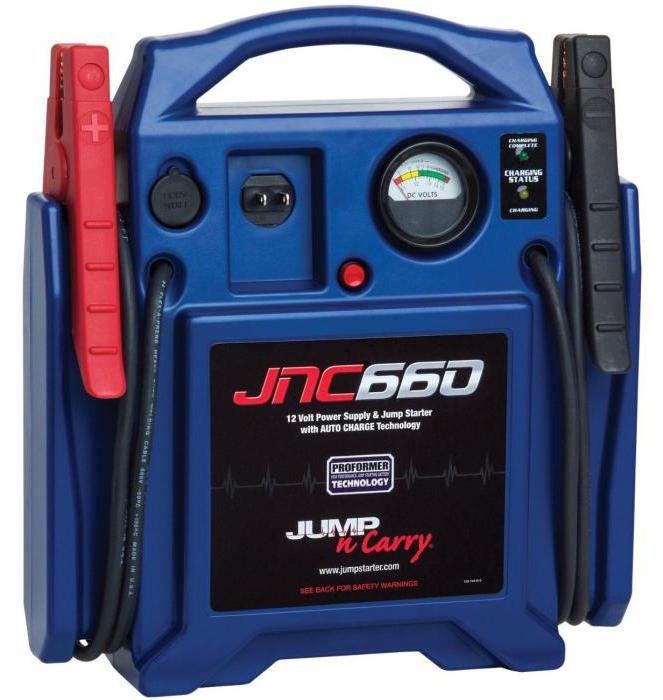 The second solution to this problem would be to contact a car repair shop equipped with modern technology which in the shortest possible time will be able to diagnose and find the cause.
The second solution to this problem would be to contact a car repair shop equipped with modern technology which in the shortest possible time will be able to diagnose and find the cause.
Actions in case of prolonged stagnation of the battery
If you are faced with the question of starting the battery after a long period of inactivity, you need to have the following knowledge:
- We start the car after a long idle time carefully, carefully.
- What does the previous action mean? This means that a 3 month downtime period will not affect the battery. And in the event of a longer downtime, you will have to carry out a certain set of measures, namely, checking vital components.
After that you need to do right choice charger. 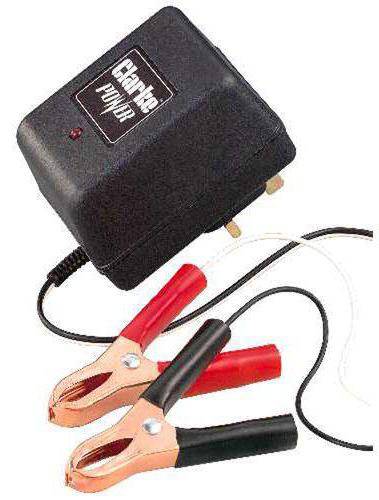 The safest method is to use a quick engine starter. Today it is the latest achievement of technology in the automotive world. This device is capable of passing a fairly large flow of energy through itself. It is this amount of energy that is enough to fully charge the engine.
The safest method is to use a quick engine starter. Today it is the latest achievement of technology in the automotive world. This device is capable of passing a fairly large flow of energy through itself. It is this amount of energy that is enough to fully charge the engine.
Terms of use
When working with such equipment, remember the following. If you start the car after a long period of inactivity, you will have to remove the battery from the vehicle and carry out a full charge. It is important not to overcharge the battery. Otherwise, it will boil, which is not the most in the best way affect its functionality. In time, high-quality batteries are charged from 1 to 2 hours. The maximum voltage is 12.5-13 V. At a lower value, the car simply will not start, at a higher value it will harm the battery.
Conclusion
Previously, when the engine failed to start at the most crucial moment, the car owner had to resort to all known manipulations: look for a “donor” for “lighting up”, charge or warm up the battery if there was no help, or even completely change the battery to a new one. In cases with primitive technique, as a rule, it was possible to get by with the “pusher” technique altogether. Now, anyone, if they take care of it in advance, can cope with such a situation alone and quickly by starting a seemingly completely dead engine with a tiny booster, the capacity of which can be comparable to three smartphones. Starting this review, we decided to collect the most diverse samples in terms of their characteristics - excellent sizes, cost and power, in order to determine which accessory is intended for what purpose. It is not by chance that you see a compact "launcher" in the foreground - we specially involved it in this review. Can compact jump starters compete with proven "battery cases"? And if so, which one to choose? Motorists are probably also concerned about more pressing issues: how reliable is such a device, for example, and whether it is convenient to use intended purpose- as a power bank to various electronic devices? Today we will find out. First you need to understand the design, because there are things here that can confuse an inexperienced car owner.
CHARGE SOURCE
The very concept of a “starter-charger”, which is now widely used, is not entirely correct: this characteristic is more suitable for devices powered by a household network that can actually charge the battery and work in the starting booster mode. The lion's share of the compact devices on the market belong to the category of starting devices and are equipped with lithium-polymer (Li-Po, Li-pol) batteries - similar ones are used in smartphones, tablets and other compact gadgets. This is currently the most modern and advanced of the massively used types of batteries. Such a battery is an advanced design of a lithium-ion battery, the main difference of which is the use of a gel-like electrolyte, which makes it very thin and gives it almost any shape. By design, the batteries are as close as possible to the batteries used in radio-controlled models and even in some modern electric vehicles, and are rectangular plates. The nominal voltage of each of them is 3.7 V, in a fully charged form - 4.2 V, and in a fully discharged form - 3 V. Further discharge, like overcharging, disables the element. That is why the battery, consisting of three series-connected elements, occupies only two-thirds of the device case: the rest of the space is reserved for electronics (controllers, DC / DC converters, capacitors, transistors, etc.).
ELUSIVE CAPACITY
Surely when choosing such a booster, as in the case of buying a smartphone, pay attention to the value called "capacity". The characteristic, of course, is important, but you need to rely on it with slight amendments: the parameter measured in ampere-hours primarily shows the magnitude of the electric charge and only partially characterizes the real capacity of the batteries. For example, the "ampere-hours" indicated on a standard car battery cannot always be compared with a similar characteristic of a jump starter. It's all about how this value is measured. For most devices, including those presented in our review, the capacity is not entirely correct, since the value in ampere-hours directly depends on the voltage at which the measurement is made: for example, at a nominal voltage of 3.7 V, the capacity of the battery booster Carku can be 15,000 mAh, when charging a smartphone through a 5-volt USB port, the capacity will be less.
To calculate the actual capacity at 5V, divide the absolute capacity (15,000mAh x 3.7V = 55,000mWh) by the USB output voltage: 55,500mWh / 5V = 11,000mAh. It is this parameter that you should focus on when charging gadgets: 11,000 mAh at a voltage of 5 V, taking into account various losses that can be 15–20%, should, for example, be enough for 4–5 full charges of a smartphone with a battery capacity of 2000 mAh.
But when the motor starts, the energy will be removed already through the starting wires, and the capacity at 12 V will be 4583 mAh. Most honestly, this value is indicated for the Whistler device, which produces 33,000 mWh - a characteristic that shows not stored charge, but stored energy. If necessary, this value can be translated into the most common capacity designation that competitors usually claim directly for the initial voltage of battery cells, divided by 3.7 V (33,000 mWh / 3.7 V = 8920 mAh) or for the most useful voltage indicator ( 12 V), which is important directly when starting the motor (33,000 mWh / 12 V = 2750 mAh). Berkut's approach can be considered no less honest: in the Smart Power booster, the capacity is indicated just for a voltage of 12 volts and is close to 2600 mAh, and when recalculated for 3.7 V, the capacity will be equal to 8432 mAh (2600 x 12 V / 3.7 V ). But why, with similar parameters, are the dimensions of the devices so different? According to the company's technical specialist, the main task in designing the device was to achieve maximum security (only Smart Power has 10 degrees of protection!), And a lot of "air" inside the case provides the batteries with better ventilation. The characteristics of the rest of the "launchers" are indicated in more familiar parameters, and the tradition itself has developed historically and is explained very simply: it is corny easier to "sell" a larger capacity. But who really stands out against this background is the heavy launcher Aurora. It has two sealed lead-acid batteries, the total capacity of which is an honest 34 Ah at 12 V, and the peak current at start-up can reach an impressive 1500 A!
READY FOR LAUNCH!
We decided to test the devices simple method without in-depth studies regarding charge currents, voltages, etc. For the test, a VAZ “classic” was chosen with a serviceable, but pre-planted battery. And in order to eliminate the effect of fast recharging during a successful engine start, it was decided to turn off the fuel supply. It is worth noting that the engine capacity is relatively small (1.5 liters), and the air temperature was kept at around 0 ° C, which, of course, made it easier for our devices to work. As a result, absolutely all gadgets successfully coped with their work, turning the crankshaft of the Zhiguli motor over and over again: each device, even the tiny Neoline, made 5 successful “launches” total length for 3–4 seconds (device manufacturers do not recommend “turning” more) and was ready for further work. After that, for greater clarity, one run of a 3.7-liter V6 was performed on a Jeep Liberty car with a planted battery. The charge remaining in the devices is roughly comparable to the declared capacity of the boosters, although the LED indicators do not make it possible to accurately assess the remaining energy. If you believe the readings of the scales, Carku, Harper, Whistler and Smart Power were discharged by 30–40%, Airline and Neoline - by 40–50%, and Aurora proved to be a completely unkillable “starter”: the starter turned the most vigorously, and the loads seemed to and didn't feel it. In this mini-test, we did not have the task of direct comparison, we mainly tried to show the variety and diversity of gadgets on sale.
Preventive charging of a healthy battery a couple of times a year minimizes the risk of its sudden discharge even in very coldy. It is more convenient to use fully automatic memory (pictured Daewoo DW 1500)
PREVENTION
As an annoying doctor, I never get tired of repeating: it is not the symptoms that need to be treated, but the cause of the disease! Even after successfully “lighting up” and turning off the engine after half an hour, the next time you start, you can fail again. The main thing is to follow simple rules operation of the battery: monitor the good contact and condition of its terminals, the serviceability of the electrical equipment of the car as a whole, the electrolyte level and its density (in serviced batteries), do not leave current consumers switched on for a long time, and if a battery malfunction is suspected, check its performance or contact to the service. After all, even daily trips (especially short-term ones) are not able to restore the battery every time to the end. Therefore, even a serviceable battery in a fully serviceable car needs preventive charging from the household network 1-2 times a year, which will minimize the likelihood of its unexpected discharge even in the most severe frost. It is most convenient to deal with automatic chargers. This time, to recharge the planted batteries, we took for a test the so-called intelligent charger of the young brand Daewoo Power Products, main feature which is to self-assess the condition of the battery and set the charging current and voltage accordingly. To put the device into operation, a minimum of actions is required: after connecting the terminals of the device to the battery contacts, the function of automatically determining the type and condition of the battery will start. If the battery is good (otherwise the corresponding inscription will light up), then after 10–15 minutes of diagnostics, you will need to select the charging mode (slow, standard or fast), after which the automatic charging process will begin. If the battery is heavily discharged, low current charging begins with a gradual increase in voltage until a normal charge level is reached. There is also a battery recovery mode (desulfation), which also works automatically: it turns on the voltage supply in a pulsed mode, which allows you to remove sulfates from the surface of the lead plates, thereby restoring the battery capacity. In general, the device turned out to be successful, especially considering its versatility (it can work with most types of 6/12/24 V batteries with a capacity of 20 to 300 Ah), safety and ease of use (protection against incorrect connection, short circuit and overheating is provided).
VERDICT
The longer a brand exists on the market, the better the quality of its products, as a rule. Moreover, the level of brand development in this area cannot be neglected: the production of starter boosters requires high-quality production and constant monitoring, which often cannot be afforded by “no-name” manufacturers. Also, the provision of a factory warranty cannot be discounted: in most cases, the manufacturer is ready to meet the needs of the client and change failed devices. No less attention should be paid when buying a jump starter technical specifications the ROM you are interested in and the possibilities of its application on certain vehicles. It is worth asking about the presence of built-in protection circuits - the more of them, the better. Of course, this will affect the cost of the device, but a good electronic device, moreover, intended for automotive use in extreme conditions will never be cheap. So, we have formed three main categories of devices provided on the market.
1. If the main task is a powerful charger for a smartphone, and the ability to start a car is an extreme case, then you can stop at budget compact models whose capacity does not exceed 8000–10,000 Ah. Airline is perfect for these purposes (on its side there are two USB ports with different characteristics, an informative display, a good flashlight and good launch options), as well as Neoline, which won over with a truly compact size. Whistler can also be attributed here: yes, it is more expensive, but its rubberized body is more practical, and the overall impression of the product is higher than that of competitors.
AIRLINE APB-08-03
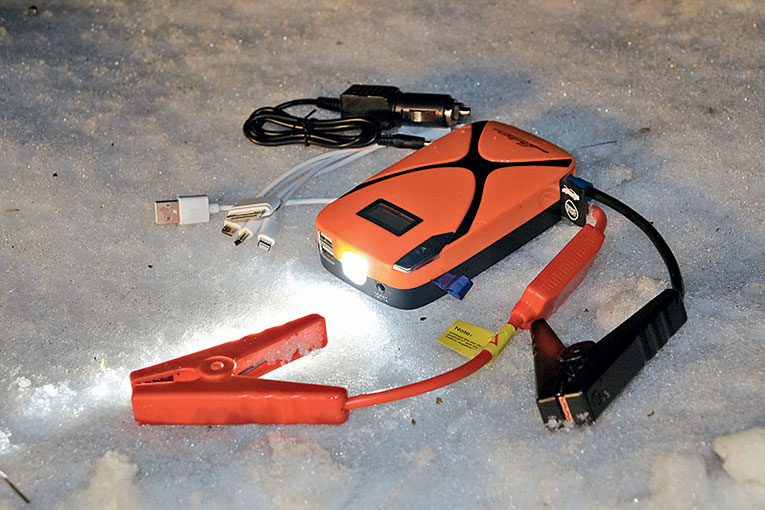
- Interesting design, compact size, LCD display, 2 USB slots
- No case included
NEOLINE JUMP STARTER 80
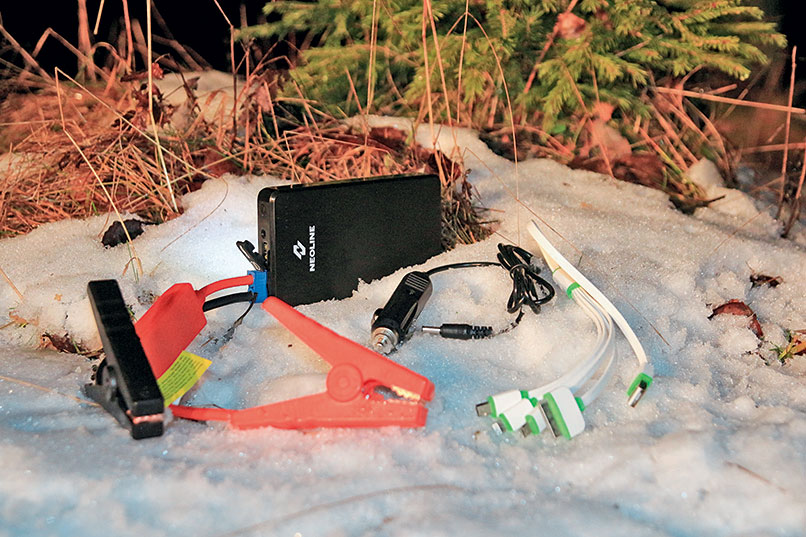
- The smallest body and weight among competitors with similar parameters, low price
- Uninformative charge indicator, no storage case, dim flashlight
WHISTLER JUMP AND GO
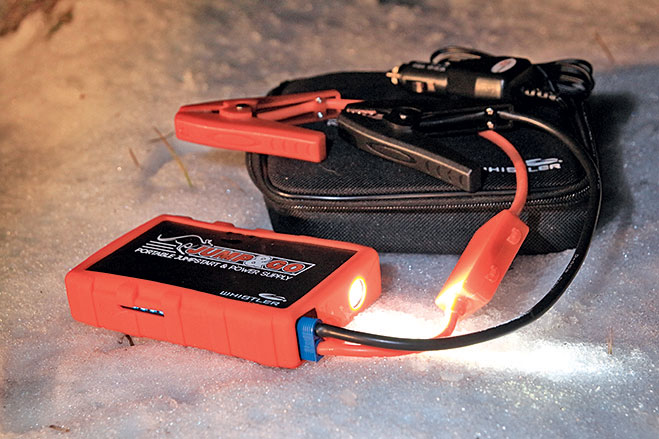
- Solid case, rubberized case, storage case, long cigarette lighter wires with soldered crocodile clips
- Uninformative charge indicator
2. If, in addition to the above requirements (charging gadgets via USB and infrequent car starts), you plan to periodically charge your laptop, then you should look at models that have an appropriate 15/19 V output. The larger the capacity, the better. In our test, only Harper turned out to have this option, although almost every manufacturer has such boosters in their assortment. I liked the device as a whole - mainly the ratio of characteristics and price.
HARPER ES 12085
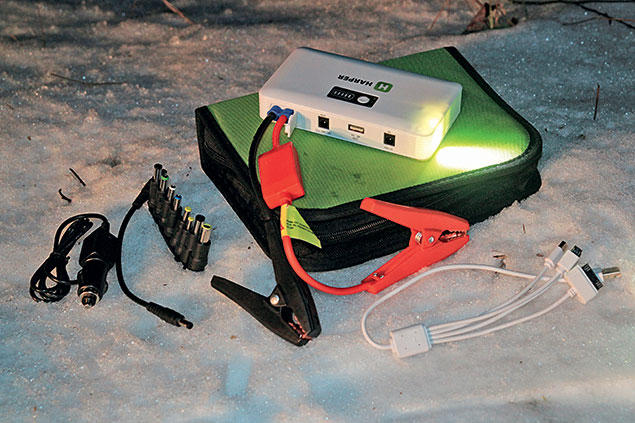
- Good equipment, the ability to charge laptops, low price
- Impractical plastic case, uninformative LED charge indicator
3. If you find yourself dealing with constant car revivals a lot (maybe you're a car mechanic, or maybe just virtue itself), then there are a few options here. Heavy equipment is still more relevant for a car service: either the Aurora Double Drive 1500 “suitcase”, or the more compact, but less productive Carku E-Power-43 and Smart Power SP-2600. Each model has its own characteristics. The Aurora really stands out among the rest of the "kids" and has a colossal capacity that allows you to launch even cargo diesel engines. You have to pay for this with a lot of weight, price and a rather long charge from the network. The Karku brand, as one of the pioneers in our market, has already gained an excellent reputation in itself - in my opinion, it is quite deserved. The tested Power-43 model is one of the few that, in addition to excellent performance, can boast of a dust and moisture resistant case. Smart Power SP-2600 has its own chips: the device has the highest degree of protection among competitors, which directly affects the safety of work, and the resource, and the reliability of the device.
AURORA DOUBLE DRIVE 1500
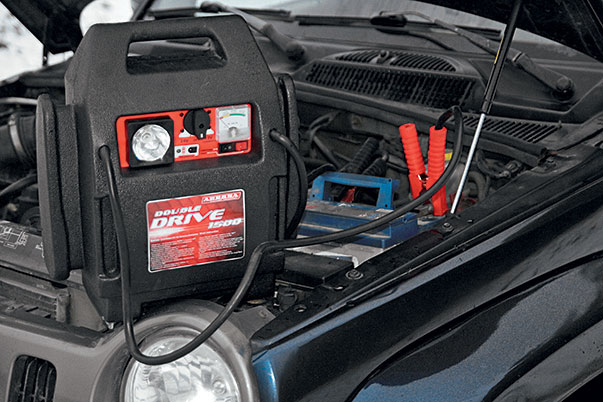
- High-quality performance, high capacitance and starting current, cigarette lighter socket, 12/24 V output, powerful power cables
- Large dimensions and weight, long charging and the need for it every 3 months
CARKU E-POWER-43
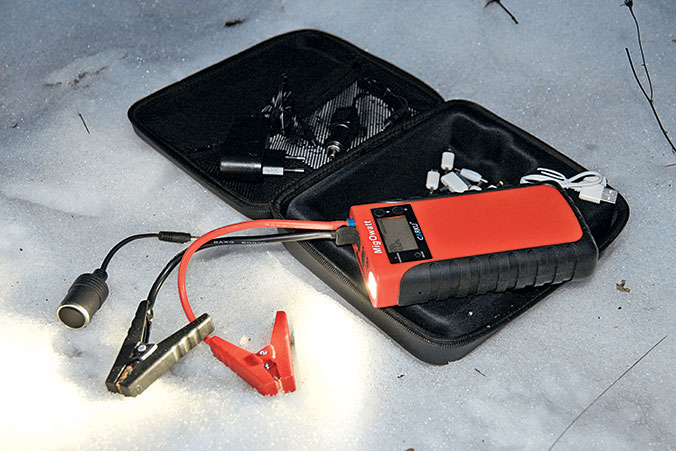
- Hard case, rich package, 12V cigarette lighter socket, large capacity, dust and moisture-proof housing, LCD display, intelligent protection unit
- Lack of 19V socket for laptop charging
SMARTPOWER SP-2600
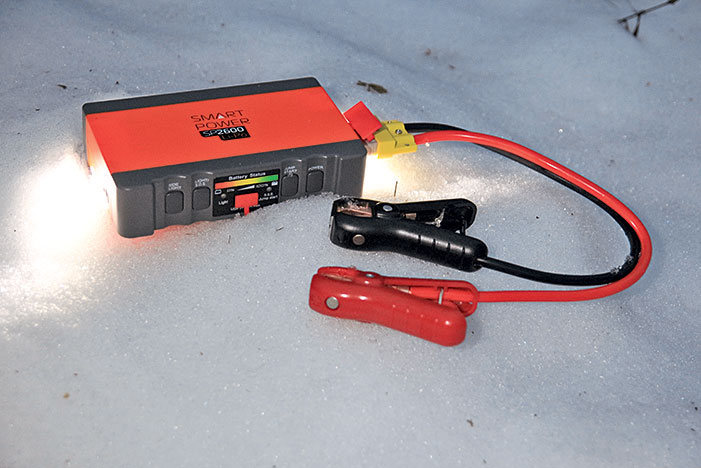
- Powerful wires for lighting, solid housing, high safety of use with 10 degrees of protection
- Price, not the most convenient "crocodiles", uninformative charge indicator, modest capacity
| Specifications | |||||||
| CARKU | HARPER | WHISTLER | SMART-POWER | AIRLINE | NEOLINE | AURORA | |
| Dimensions, mm | 265x190x60 | 145x80x30 | 130x78x24 | 192x122x47 | - | 131x75x25 | |
| Weight, g | 590 | 420 | 450 | 660 | 500 | 225 | 11 500 |
| USB output (5 V), A | 2 | 2 | 2,1 | 2 | 2,1 + 1 | 2 | - |
| Ability to charge a laptop | - | 12/16/19 V | - | - | - | - | - |
| cigarette lighter socket | 12 V, 10 A | - | - | - | - | - | 12 V |
| Capacity, (mAh) at 3.7 V | 15 000 | 12 000 | 8920 | 8432; 2600 (at 12V) | 8000 | 8000 | 37 000 |
| Stored energy, Wh (approximately) | 55 | 44,4 | 33 (passport data) | 31,2 | 29,6 | 29,6 | 444 |
| Starting current, A (min./max.) | 250/500 | 200/400 | 200/400 | 117/234 | 200/400 | 200/400 | 700/1500 |
| Charging time, h | 4–5 | 3 | 3–4 | - | - | - | - |
| Charge indicator | LCD display | LED scale | LED scale | LED scale | LCD display | LED scale | turnout |
| Flashlight | There is | There is | There is | 2 pcs. | There is | There is | There is |
| Charging cycles | >1000 | 1200 | >1000 | 2000 | 3000 | 1000 | - |
| Price, r. | 7990 | 4200 | 7190 | 9200 | 4900 | 3500 | 10 100 |
In the winter cold in the morning, it is very tempting to buy a device to start the engine with a dead battery. Probably, there is no driver in nature who would not ask at least once to light a cigarette from neighbors in the parking lot or did not look for sympathizers to push his car (naturally, in the latter case, the car must be equipped with mechanical box).
Even attentive and caring car owners are not guaranteed against a sudden battery landing: in the cold, it holds a charge poorly, even if it has not yet had time to grow old. Constantly relying on someone's help is not very reasonable: everyone can have time to leave the parking lot, or no one will find crocodiles, or there will be no time to wait until your battery comes to life.
Spend money for optional equipment, of course, it's a pity, but a one-time investment can save a lot of nerves and time.
Device for starting the engine with a dead battery may have different manufacturers: such units are produced by both Asian companies and firms of the CIS countries.
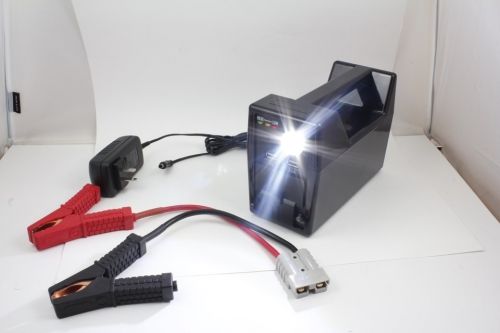
Start charger as such
The device is better known among the people under the name "booster". Unenlightened people believe that this is a kind of spare battery. The deepest delusion: charging has at least 3 cardinal differences:
- the capacity of the booster is much less than that of the on-board battery (maximum 30Ah);
- completely different internal content - lead-electrolyte;
- produces an inrush current of 1000 A or more.
- The starting device is connected directly to the engine. Such a booster is only suitable for cars where the engine is not more powerful than 125 horses;
- The unit is thrown by the same “crocodiles” directly onto a dead battery and gives a current sufficient to start and initially recharge (then the generator comes into play).
Boosters are charged from a household electrical outlet. In the cold, you should not leave them in the car: the fate of the on-board battery may befall. However, almost all of them are quite compact. The only exceptions are professional and semi-professional, with which they come to the rescue from a car service: they can weigh up to 5-7 kg.
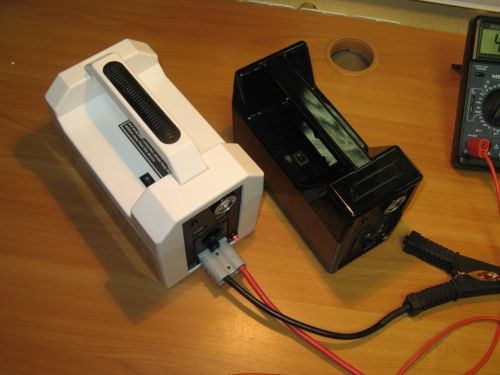
Booster functionality
If you have already decided to acquire such a device, choose one that will be convenient to use - and not only to start the engine.
- When choosing a model, choose one with a battery indicator. Without such a scoreboard, using a booster will be, to put it mildly, inconvenient;
- Spend a little more money, but buy a device with built-in zero discharge protection: this model will last much longer;
- It is advisable to choose a booster that provides the ability to charge other devices. For example, the Russian s-start at the output provides voltage 5V/2A, 12V/2A, 19V/3.5A, thanks to which it can be used to recharge tablets, smartphones and even a laptop. USB ports and adapters are available;
- When buying a booster, pay attention to its power: for example, Taiwanese-made devices are clearly distinguished by purpose - for cars and jeeps;
- There are flashlights in almost all launchers. But whether you need additional functions - decide for yourself.
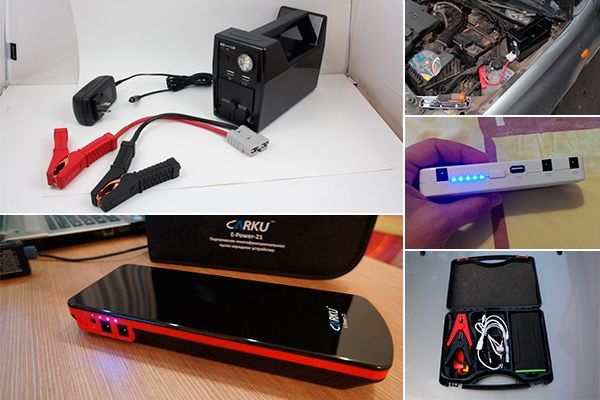
Don't get divorced!
Hundreds, and maybe thousands of motorists have already become victims of advertising. A dubious device called the Start Genie is selling like hot cakes. Gentlemen, learn the materiel and think logically! If the majority of high-quality boosters start at $150, and the simplest ones start from 5 thousand rubles, then the cost of 1.5-1.9 thousand should at least alert.
The use of this charger should cause no less embarrassment: Start Genie sticks into ... the cigarette lighter!
To start the engine, even for a low-power car, you need a message of 200 A, and the cigarette lighter can withstand only 15. It is simply not able to transmit the current of the required strength. Firstly, it will burn itself out, and secondly, it’s scary to even imagine what will happen to the computer if it is on the car. Enthusiasts who bought the Start Genie, tried to charge it and failed to do so, broke open the booster case and found 20 AA batteries in it. Almost 2 thousand for this kit seems a bit expensive.
Remember: a real device for starting the engine with a dead battery is thrown onto it or the motor, and not into a hole designed for completely different purposes.
How to choose a launcher?
These cars are popularly called "boosters", "jump starters", "tarzans" and so on.
A small case that weighs, depending on the power, from 6 to 20 kg., will help the car battery to crank the starter. Also, the device can be used as an alternative source of energy when replacing a standard battery or during repair work, if it is necessary to disconnect the battery for power supply. on-board computer, alarms, etc.
Let's see how this device works and how it differs from a conventional car battery?
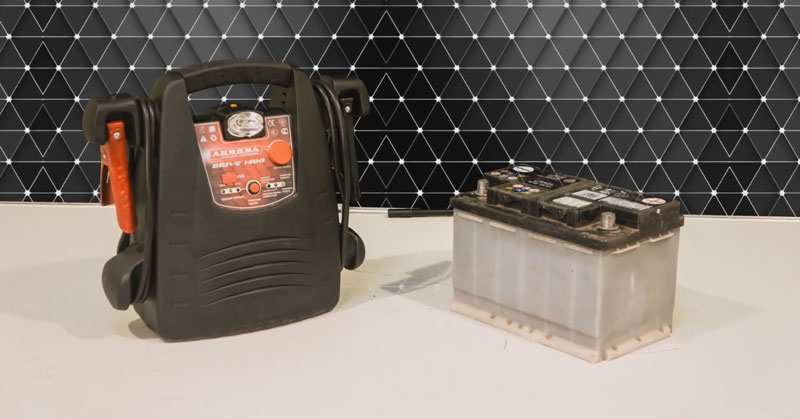
Booster - is a sealed battery, or several batteries packed in a convenient case. The device is equipped with an electronic charge control board, power cables with crocodile clips, a flashlight, a mains charger and a cable for charging the battery from the car's on-board network. Some models of devices have USB outputs powered by 5V.
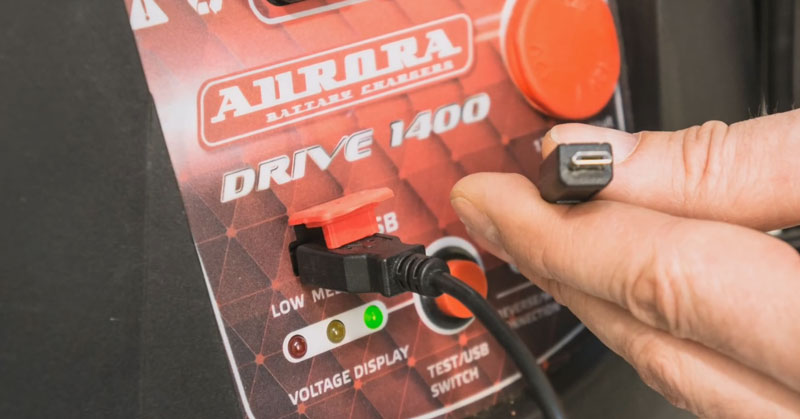
In order to choose the booster you need, you need to pay attention to several important points- this is the voltage of the standard battery (12 or 24V), the required starting current and the capacity of the car battery.
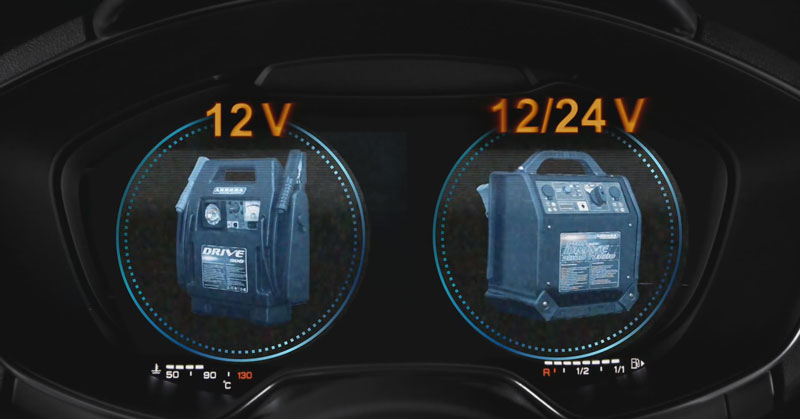
According to the first criterion, devices can be divided into 2 categories:
12-volt DRIVE series devices that are suitable for starting cars, snowmobiles, generators and other similar equipment
24-volt devices of the DOUBLE DRIVE series (which, by the way, can also work with 12V batteries) are suitable for starting engines of powerful construction equipment, trucks, etc.
As for the starting current, there is a small but important nuance here: in those. The characteristics of the starting devices indicate 2 parameters of the starting current:
Peak value and Rated
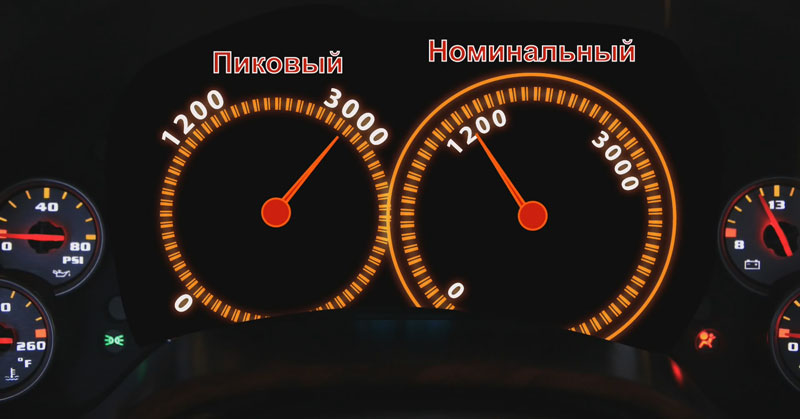
The peak starting current is much higher than the rated current and represents the value of the current that flows in the first fractions of a second of starting. This indicator shows how powerful the “starter” is able to give out an impulse in order to crank the starter.
The nominal value is an indicator of the strength of the starting current that the device is capable of delivering during a 3-second startup cycle.
As you understand, the higher the current parameters, the better.
The choice of a booster also depends on the capacity of the car's battery - the larger it is, the greater the capacity should be the battery of the starting device. So, to start a motorcycle, a launcher with a battery capacity of 17A / h will be more than enough, and a truck will need a battery with a larger capacity, for example, as on the Double Drive 3000 Turbo, which has 2 batteries installed, with a total capacity of 44A / h.
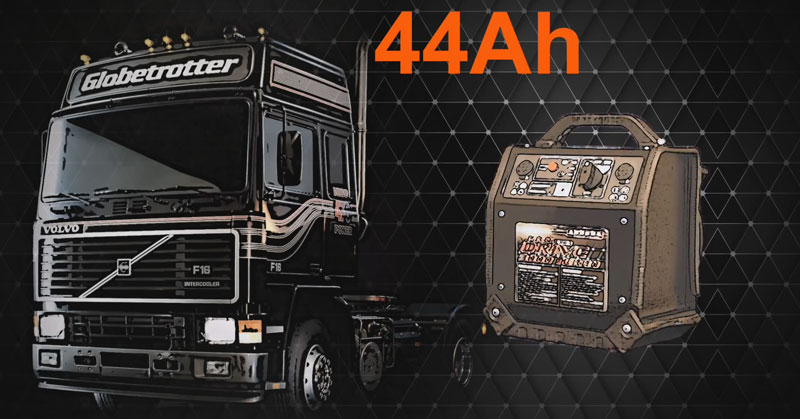
The buyer should know that the number of engine starts on one charge of the “jump starter” directly depends on the capacity of the device’s batteries and the degree of discharge of the regular car battery. The larger the battery capacity of the device, the more attempts to start the car owner can make.
For example, the battery capacity of the junior model in the AURORA DRIVE 900 line is 17 Ah,
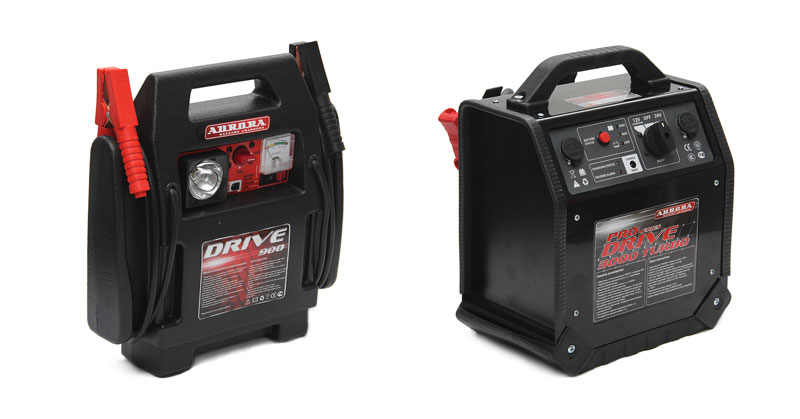
and the professional model AURORA DOUBLE DRIVE 3000 TURBO
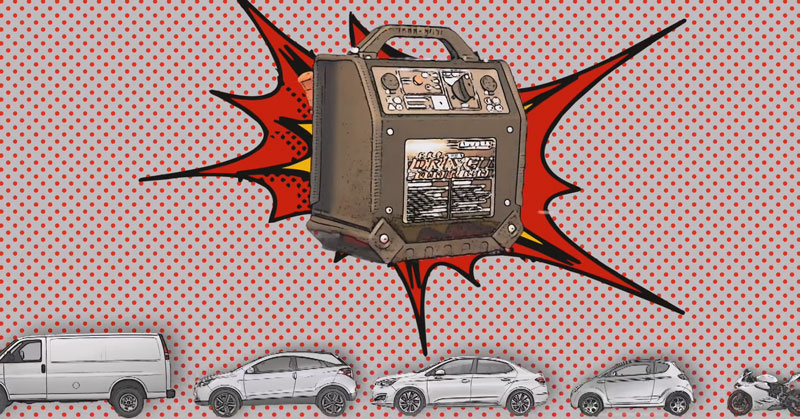
The capacity of two built-in batteries is 44 Ah.
Motorists often face the problem of a dead battery in the cold season, as accumulator battery tends to discharge much faster as a result of large temperature fluctuations. Accelerated discharge occurs due to the fact that the car has to turn the starter longer in winter, as the fuel evaporates worse, the oil in the crankcase gets stuck, etc.
In urban conditions, trips are often short, which is not enough to subsequently replenish the battery charge from the generator used to start. Also, drivers in cold weather actively use additional electrical equipment during downtime (heating mirrors, seats, etc.). In such conditions, the car may not start from the battery at the most inopportune moment. The most convenient solution in such a situation is an autonomous start-up charger, known by the additional everyday name "booster".
How to quickly start a car with a booster if the battery is dead?

The use of an autonomous start-charger is optimal in an emergency, since searches for a charged battery are excluded, there is no need to “light up” from another car, there are no difficulties and risks associated with a mechanical start “from a pusher”.
The presence of an engine starter charger becomes especially relevant for the reason that an incorrectly implemented “lighting up” procedure can disable the electrical equipment of the machine from which they light up, as well as the one they are trying to start. Attempts to start the engine from a jolt can damage the mechanical transmission or even the internal combustion engine. inexperienced driver. As for vehicles with automatic transmission shifting gears, then it is completely forbidden to try to start such cars in this way.
The stand-alone starter charger is a miniature battery with the possibility of recharging it from a household outlet, which is connected directly to the motor passenger car with an engine capacity of about 2.0 liters and an approximate power of up to 130 "horses".
You can connect the booster either separately or directly to the installed battery by installing special fasteners on the battery terminals, more commonly known as "crocodiles". The starter charger is capable of supplying enough current to start the motor and maintain its further stable operation.
A starter charger for a successful engine start will require the user to follow just a few simple rules:
- the device must be charged;
- observe the polarity when connecting;
- do not turn the motor with a starter from the booster for more than 10 seconds;
- intervals between attempts to start the internal combustion engine are about 5 seconds;
Choosing a car charger
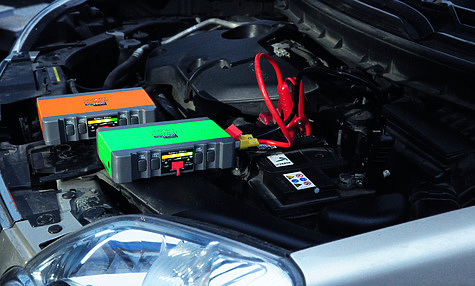
Today, products of world and domestic manufacturers are widely represented on sale. Booster models can only perform the main function, and also be multifunctional. Please note that the booster cannot be considered as a full-fledged alternative to the battery. Solutions often have a capacity index of about 30 Ah and a starting current of 1000 A. The internal structure of the battery in starting chargers also differs from a regular car battery in terms of materials of manufacture.
In the list of the main differences between boosters from each other, it is worth noting the power, options and the price of launchers. The initial cost of the simplest solutions of acceptable quality is about 130 US dollars, for the top ones they ask for 650-750 USD.
- When choosing a device, it is recommended to pay attention to the fact that there is a special automatic protection in case the polarity of the terminals was reversed during connection.
- It is highly recommended to purchase a booster that is equipped with a battery indicator. The specified indicator will allow you to easily control the level of charge of the device, as well as always keep the booster in full readiness for work.
- Also a useful feature is protection against deep or full discharge of the booster. The presence of this option will significantly extend the life of the launcher.




